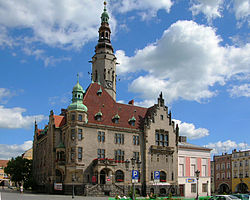Jawor
| Jawor | ||
|---|---|---|

Town hall
|
||
|
||
| Coordinates: 51°03′N 16°12′E / 51.050°N 16.200°E | ||
| Country |
|
|
| Voivodeship | Lower Silesian | |
| County | Jawor County | |
| Gmina | Jawor (urban gmina) | |
| Government | ||
| • Mayor | Emilian Bera | |
| Area | ||
| • Total | 18.8 km2 (7.3 sq mi) | |
| Population (2006) | ||
| • Total | 24,347 | |
| • Density | 1,300/km2 (3,400/sq mi) | |
| Time zone | CET (UTC+1) | |
| • Summer (DST) | CEST (UTC+2) | |
| Postal code | 59-400 | |
| Car plates | DJA | |
| Website | http://www.jawor.pl | |
Jawor [ˈjavɔr] (German: Jauer) is a town in south-western Poland with 24,347 inhabitants (2006). It is situated in Lower Silesian Voivodeship (from 1975–1998 it was in the former Legnica Voivodeship). It is the seat of Jawor County, and lies approximately 61 kilometres (38 mi) west of the regional capital Wrocław.
In the town can be found a Protestant Church of Peace. It was named a UNESCO World Heritage Site in 2001. Jawor Castle lies in Jawor.
The name Jawor is Polish for "sycamore". Prior to 1945, the town was part of Poland, Bohemia, Austria, Prussia and Germany. After World War II the region was placed under Polish administration by the Potsdam Agreement under territorial changes demanded by the Soviet Union. Most Germans fled or were expelled and were replaced with Poles expelled from the Polish areas annexed by the Soviet Union.
Church of Peace
Church of Peace, interior
Buildings in Jawor
Jawor old market square
Frescoe in the church
Coordinates: 51°03′N 16°12′E / 51.050°N 16.200°E
...
Wikipedia


